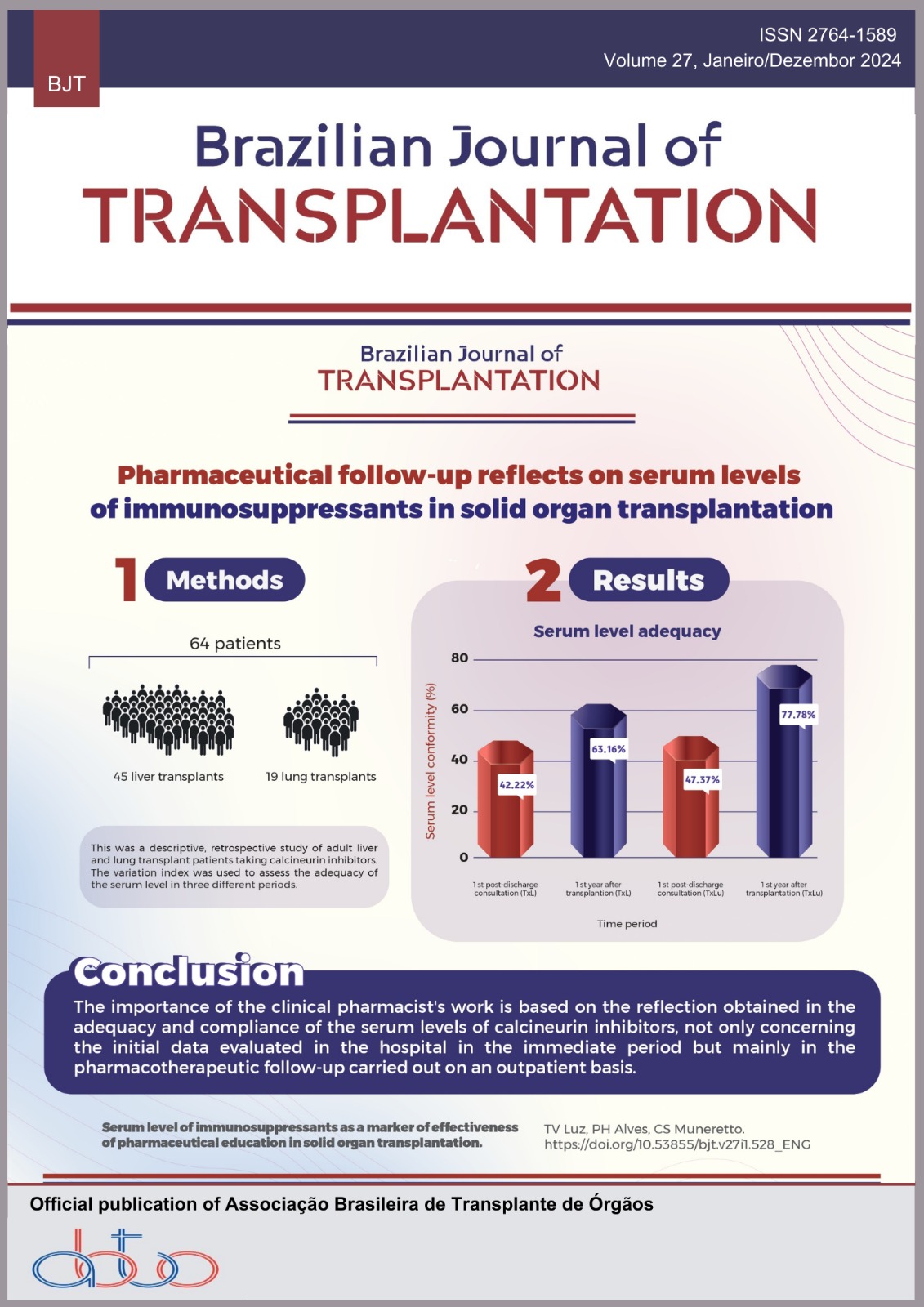Factors Associated with Waitlist Time on Liver Transplantation
Keywords:
Liver Transplantation, MELD, Health, Waitlist, Quality, Performance ImprovementAbstract
Objectives: Liver transplantation (LT) is the main therapy for patients with cirrhosis or fulminant liver failure. However, there is a disproportion between the demand and availability of organs, such that the waitlist mortality ranged from 20 to 38% when the only allocation criterion was the time of inclusion on the waitlist. Brazil then adopted the Model for End-stage Liver Disease (MELD) score, aiming to prioritize patients with a higher risk of death for LT. Therefore, this study aimed to determine factors associated with waitlist time for LT. Methods: Retrospective cohort study of adult patients listed for LT from October 2012 to December 2019 in a single state in Brazil. Results: !e study analyzes 1,262 patients (869 males, 68.91%; median age, 53.33 ± 11.48 years; median waitlist time, 103.88 ± 162.05 days; median MELD Sodium [MELD-Na] score of 22.41 ± 6.09). Alcoholic liver cirrhosis (n = 369; 29.24%) and chronic viral hepatitis (n = 295; 23.38%) were the most prevalent reasons for LT. Blood groups O (n = 534; 42.31%) and A (n = 474; 37.56%) prevailed among the recipients. !e state capital and its metropolitan region accounted for 91.20% (n = 1,151) of all liver transplants performed. Most donors were deceased (n = 1,258; 99.68%). Patients with MELD-Na scores > 21 (p < 0.001), non-O blood group (p = 0.002), age < 53 years (p = 0.003), and those listed " 2017 spent # 30 days on the waitlist (p < 0.001). Conclusion: A waitlist period of # 30 days was associated with higher MELD-Na scores, younger ages, non-O blood groups, and LT listings before 2017.
Downloads
References
Meirelles Júnior RF, Salvalaggio P, Rezende MB, Evangelista AS, Guardia BD, Matielo CE, et al. Liver transplantation: history, outcomes and perspectives. Einstein (Sao Paulo) 2015; 13(1): 149-52. https://doi.org/10.1590/S1679-45082015RW3164
Chaib E, Massad E. Liver transplantation: waiting list dynamics in the state of São Paulo, Brazil. Transplant Proc 2005; 37(10): 4329-30. https://doi.org/10.1016/j.transproceed.2005.11.014
Ahmad J, Downey KK, Akoad M, Cacciarelli TV. Impact of the MELD score on waiting time and disease severity in liver transplantation in United States veterans. Liver Transpl 2007; 13(11):1564-9. https://doi.org/10.1002/lt.21262
Wiesner R, Edwards E, Freeman R, Harper A, Kim R, Kamath P, et al. United Network for Organ Sharing Liver Disease Severity Score Committee. Gastroenterology 2003;124: 91-6. https://doi.org/10.1053/gast.2003.50016
Trieu JA, Bilal M, Hmoud B. Factors associated with waiting time on the liver transplant list: an analysis of the United Network for Organ Sharing (UNOS) database. Ann Gastroenterol 2018; 31(1): 84-9. https://doi.org/10.20524%2Faog.2017.0217
Neuberger J. Liver transplantation in the United Kingdom. Liver Transplant 2016; 22(8): 1129-35. https://doi.org/10.1002/lt.24462
Lynch RJ, Patzer RE. Geographic inequity in transplant access. Curr Opin Organ Transplant 2019; 24(3): 337-42. https://doi.org/10.1097/MOT.0000000000000643
Puri V, Hachem RR, Frye CC, Harrison MS, Semenkovich TR, Lynch JP, et al. Unintended consequences of changes to lung allocation policy. Am J Transplant 2019; 19(8): 2164-7. https://doi.org/10.1111/ajt.15307
IJtsma AJC, van der Hilst CS, Nijkamp DM, Bottema JT, Fidler V, Porte RJ, et al. Does the meld system provide equal access to liver transplantation for patients with different ABO blood groups? Transpl Int 2016; 29(8): 883-9. https://doi.org/10.1111/tri.12774
Barone M, Avolio AW, Di Leo A, Burra P, Francavilla A. ABO blood group-related waiting list disparities in liver transplant candidates: effect of the MELD adoption. Transplantation 2008; 85(6): 844-9. https://doi.org/10.1097/TP.0b013e318166cc38
Downloads
Published
How to Cite
Issue
Section
License
Copyright (c) 2024 João Gabriel Vicentini Karvat, Gabriela do Rego Monteiro, Julia Gabriela Oliveira Marchiori, Matteus Cesar Miglioli, Natália Bernardi Ribeiro, Jean Rodrigo Tafarel

This work is licensed under a Creative Commons Attribution 4.0 International License.









